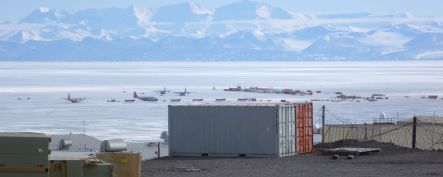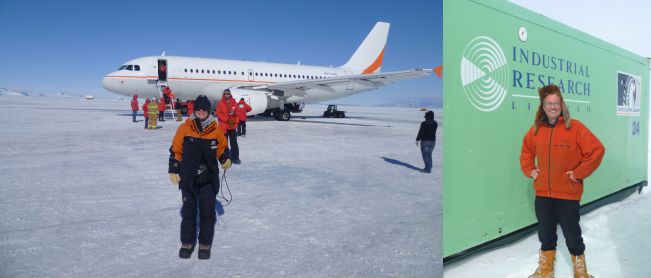
From spring until early December, when the sea ice begins to break up, the sea ice in front of McMurdo Station serves as an ice runway strong enough to land C17 planes on (image: A. Ballance)
At the end of 2010, Alison Ballance spent several weeks at Scott Base in Antarctica, finding out about the varied science programmes that are supported by Antarctica New Zealand. She went from nearly the summit of Mount Erebus, out onto the sea ice and into the southern Dry Valleys in search of scientists working on topics ranging from microbes living in thermally heated soils, to fish leech antifreeze and quantifying the dust that blows onto the sea ice each year. This Antarctic Science series will play over the next few months, and kicks off tonight with a story about the physics of sea ice.
The formation of sea ice around Antarctica each winter nearly doubles the size of the frozen continent, and is one of the largest annual geophysical events on the planet (rivaled in size by another Antarctic phenomenon, the ozone hole). In just a few months the sea ice can develop thicknesses of more than 2 metres, and is strong enough for planes to land on - from September to early December planes as large as a C17 land on a sea ice runway directly in front of McMurdo Station.
Tim Haskell is a Distinguished Scientist at IRL, and recipient of the 2006 New Zealand Association of Scientist's Marsden Medal and the 2008 Antarctic medal. In 2009 a significant Antarctic strait lying under the permanent McMurdo Ice Shelf, about as wide as Cook Strait and up to 900 metres deep in places, was named Haskell Strait in his honour. He has been studying the physics of sea ice for 30 years, and Alison catches up with him at his research camp on the sea ice to hear how he got involved in sea ice research, and what he finds interesting about it. Tim Haskell collaborates closely with various university teams as well as NIWA.

Alison Ballance, upon arrival in Antarctica, with the Airbus on which she travelled sitting on the sea ice runway, and Tim Haskell at his sea ice field camp on his 1000th day 'on ice' (images: A. Ballance)


